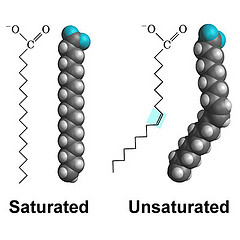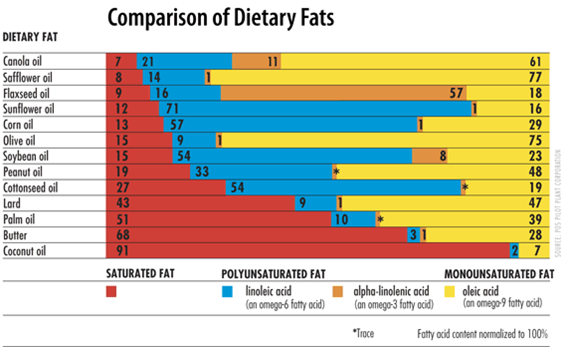- Saturated Fats are GOOD
- Polyunsaturated Fats are BAD
- Room temperature determines if it is a fat or an oil. Fat is solid at room temperature and oils are liquid.
- All Fat and Oils are made up of a combination of Saturated, Monounsaturated and Polyunsaturated fats.
- Polyunsaturated fats are more likely to become oxidised than saturated fats
- Polyunsaturated fats create more inflammation – simple as that.
- The proportion of Saturated, Monounsaturated and Polyunsaturated fats within our circulating lipoproteins and within tissue fat stores is the same as our diet.
The NoFructose Handout Starter Sheet is your take away summary of this web site. Read it at the NoFructose Starter Sheet area of this web site or download it.
IDEAS
The main determinant of the proportion of Saturated, Monounsaturated and Polyunsaturated fats within our circulating lipoproteins and within tissue fat stores is the same as our dietary intake. The western, modern diet has changed to a greater portion of Polyunsaturated fats over the last 50 to 100 years and this is reflected in the tissue accumulation of this component.
The more oxidation that occurs, the more inflammation – therefore minimise the intake of Polyunsaturated fats and oils.
The accumulation of fat that occurs in the blood vessel wall of every organ in the body results in an ongoing inflammatory process in every organ.
This creates an inflamed, susceptible environment in every organ of the body. It is then at risk to other stimuli which result in further tissue damage and disease processes.
Cutting back on the Polyunsaturated component and increasing the Saturated component SHOULD result in less inflammation in the vessels and organs.
The consumption of Sugar and Polyunsaturated Seed Oils combine in our diet to create inflammation in every blood vessel wall and in every tissue in every organ of the body. The inflammatory process makes everything susceptible to damage and disease.
MORE INFORMATION
Saturated fats are ‘saturated’ with no double bonds to allow flexibility. That is why they are solid at room temperature.
Monounsaturated fats have a single double bond in them and are a little flexible.
Polyunsaturated fats have multiple double bonds in them allowing greater flexibility and particularly at low temperatures. That is why plants (with seeds) can survive at low temperatures as the transport system within them does not solidify. Seed oils have a greater proportion of Polyunsaturated fat within them.
Animal fats such as butter and lard have a higher proportion of Saturated and Monounsaturated fats.
Seed oils such as Sunflower Oil, Canola Oil and Vegetable Oil have a higher proportion of Polyunsaturated fat within them. No oil or fat is 100% saturated or polyunsaturated. The chart below gives a guide to proportions.
The Fruit Oils such as Olive Oil and Avocado Oil have mixed proportions. Coconut Oil has a very high Saturated proportion.
The double bonds that are available in a fat allow for oxidation to occur at a tissue level. If there are no double bonds, then no oxidation. Oxidation is like rust on exposed steel.
Polyunsaturated fats are more likely to become oxidised than saturated fats with no double bonds exposed.
The more oxidation that occurs, the more inflammation – simple as that.
Current research suggests that the consumption of saturated fats and oils found in animal fats such as butter and lard are protective. The polyunsaturated fats which are generally found in a higher percentage within the seed oils may be appear to be a significant contributing factor to the majority of the Western diseases. They are the metabolically active components of lipoproteins that are being oxidised within the subintimal layer of the vessel wall.
Eating Ideas
To address the blood vessel wall inflammation in every part of your body, andin addition to cutting back on Fructose – Minimise Polyunsaturated Fats and Oils
Change from the Margarine, Canola, Vegetable and Seed Oils.
Better to cook with Butter and Lard, Olive Oil or Coconut Oil – do not overheat.
You still need to watch the calories!
______________
Is Canola Oil Good for you? – Not by my reckoning.
http://authoritynutrition.com/canola-oil-good-or-bad/
Read about the Damage Process
Read about the Metabolism
Read about the Health Issues
The NoFructose Handout Starter Sheet is your take away summary of this web site. Read it at the NoFructose Starter Sheet area of this web site or download it.
Meta-analysis of prospective cohort studies evaluating the association of saturated fat with cardiovascular disease1,2,3,4,5
Objective: The objective of this meta-analysis was to summarize the evidence related to the association of dietary saturated fat with risk of coronary heart disease (CHD), stroke, and cardiovascular disease (CVD; CHD inclusive of stroke) in prospective epidemiologic studies.
Design: Twenty-one studies identified by searching MEDLINE and EMBASE databases and secondary referencing qualified for inclusion in this study. A random-effects model was used to derive composite relative risk estimates for CHD, stroke, and CVD.
Results: During 5–23 y of follow-up of 347,747 subjects, 11,006 developed CHD or stroke. Intake of saturated fat was not associated with an increased risk of CHD, stroke, or CVD. The pooled relative risk estimates that compared extreme quantiles of saturated fat intake were 1.07 (95% CI: 0.96, 1.19; P = 0.22) for CHD, 0.81 (95% CI: 0.62, 1.05; P = 0.11) for stroke, and 1.00 (95% CI: 0.89, 1.11; P = 0.95) for CVD. Consideration of age, sex, and study quality did not change the results.
Conclusions: A meta-analysis of prospective epidemiologic studies showed that there is no significant evidence for concluding that dietary saturated fat is associated with an increased risk of CHD or CVD. More data are needed to elucidate whether CVD risks are likely to be influenced by the specific nutrients used to replace saturated fat.
Dietary fats and health: dietary recommendations in the context of scientific evidence.
Although early studies showed that saturated fat diets with very low levels of PUFAs increase serum cholesterol, whereas other studies showed high serum cholesterol increased the risk of coronary artery disease (CAD), the evidence of dietary saturated fats increasing CAD or causing premature death was weak. Over the years, data revealed that dietary saturated fatty acids (SFAs) are not associated with CAD and other adverse health effects or at worst are weakly associated in some analyses when other contributing factors may be overlooked. Several recent analyses indicate that SFAs, particularly in dairy products and coconut oil, can improve health. The evidence of ω6 polyunsaturated fatty acids (PUFAs) promoting inflammation and augmenting many diseases continues to grow, whereas ω3 PUFAs seem to counter these adverse effects. The replacement of saturated fats in the diet with carbohydrates, especially sugars, has resulted in increased obesity and its associated health complications. Well-established mechanisms have been proposed for the adverse health effects of some alternative or replacement nutrients, such as simple carbohydrates and PUFAs. The focus on dietary manipulation of serum cholesterol may be moot in view of numerous other factors that increase the risk of heart disease. The adverse health effects that have been associated with saturated fats in the past are most likely due to factors other than SFAs, which are discussed here. This review calls for a rational reevaluation of existing dietary recommendations that focus on minimizing dietary SFAs, for which mechanisms for adverse health effects are lacking.
_______________________________________
Serum triglycerides as a risk factor for cardiovascular diseases in the Asia-Pacific region.
Circulation. 2004 Oct 26;110(17):2678-86. Epub 2004 Oct 18.
We performed an individual participant data meta-analysis of prospective studies conducted in the Asia-Pacific region. Cox models were applied to the combined data from 26 studies to estimate the overall and region-, sex-, and age-specific hazard ratios for major cardiovascular diseases by fifths of triglyceride values. During 796,671 person-years of follow-up among 96,224 individuals, 670 and 667 deaths as a result of coronary heart disease (CHD) and stroke, respectively, were recorded. After adjustment for major cardiovascular risk factors, participants grouped in the highest fifth of triglyceride levels had a 70% (95% CI, 47 to 96) greater risk of CHD death, an 80% (95% CI, 49 to 119) higher risk of fatal or nonfatal CHD, and a 50% (95% CI, 29% to 76%) increased risk of fatal or nonfatal stroke compared with those belonging to the lowest fifth. The association between triglycerides and CHD death was similar across subgroups defined by ethnicity, age, and sex.
CONCLUSIONS:Serum triglycerides are an important and independent predictor of CHD and stroke risk in the Asia-Pacific region. These results may have clinical implications for cardiovascular risk prediction and the use of lipid-lowering therap
______________________________________________
Saturated fat is not the major issue
Int J Vitam Nutr Res. 1998;68(3):159-73.
Can adults adequately convert alpha-linolenic acid (18:3n-3) to eicosapentaenoic acid (20:5n-3) and docosahexaenoic acid (22:6n-3)?
Abstract
A diet including 2-3 portions of fatty fish per week, which corresponds to the intake of 1.25 g EPA (20:5n-3) + DHA (22:6n-3) per day, has been officially recommended on the basis of epidemiological findings showing a beneficial role of these n-3 long-chain PUFA in the prevention of cardiovascular and inflammatory diseases. The parent fatty acid ALA (18:3n-3), found in vegetable oils such as flaxseed or rapeseed oil, is used by the human organism partly as a source of energy, partly as a precursor of the metabolites, but the degree of conversion appears to be unreliable and restricted. More specifically, most studies in humans have shown that whereas a certain, though restricted, conversion of high doses of ALA to EPA occurs, conversion to DHA is severely restricted. The use of ALA labelled with radioisotopes suggested that with a background diet high in saturated fat conversion to long-chain metabolites is approximately 6% for EPA and 3.8% for DHA. With a diet rich in n-6 PUFA, conversion is reduced by 40 to 50%. It is thus reasonable to observe an n-6/n-3 PUFA ratio not exceeding 4-6. Restricted conversion to DHA may be critical since evidence has been increasing that this long-chain metabolite has an autonomous function, e.g. in the brain, retina and spermatozoa where it is the most prominent fatty acid. In neonates deficiency is associated with visual impairment, abnormalities in the electroretinogram and delayed cognitive development. In adults the potential role of DHA in neurological function still needs to be investigated in depth. Regarding cardiovascular risk factors DHA has been shown to reduce triglyceride concentrations. These findings indicate that future attention will have to focus on the adequate provision of DHA which can reliably be achieved only with the supply of the preformed long-chain metabolite.
_______________
Conversion of alpha-linolenic acid to longer-chain polyunsaturated fatty acids in human adults.
http://rnd.edpsciences.org/articles/rnd/abs/2005/05/r5505/r5505.html
The principal biological role of alpha-linolenic acid (alphaLNA; 18:3n-3) appears to be as a precursor for the synthesis of longer chain n-3 polyunsaturated fatty acids (PUFA). Increasing alphaLNA intake for a period of weeks to months results in an increase in the proportion of eicosapentaenoic acid (EPA; 20:5n-3) in plasma lipids, in erythrocytes, leukocytes, platelets and in breast milk but there is no increase in docosahexaenoic acid (DHA; 22:6n-3), which may even decline in some pools at high alphaLNA intakes. Stable isotope tracer studies indicate that conversion of alphaLNA to EPA occurs but is limited in men and that further transformation to DHA is very low. The fractional conversion of alphaLNA to the longer chain n-3 PUFA is greater in women which may be due to a regulatory effect of oestrogen. A lower proportion of alphaLNA is used for beta-oxidation in women compared with men. Overall, alphaLNA appears to be a limited source of longer chain n-3 PUFA in humans. Thus, adequate intakes of preformed long chain n-3 PUFA, in particular DHA, may be important for maintaining optimal tissue function. Capacity to up-regulate alphaLNA conversion in women may be important for meeting the demands of the fetus and neonate for DHA.
_________________________________

